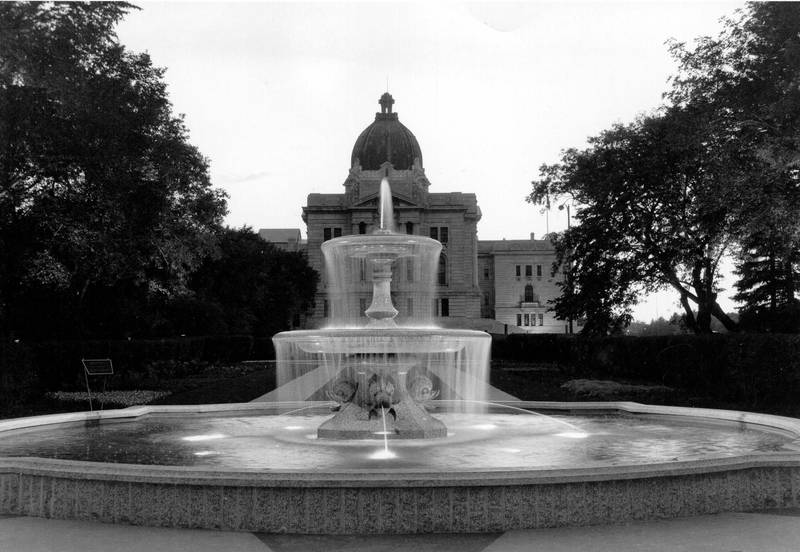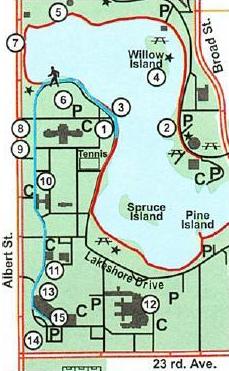
1.73 kilometres - 25 minutes

- This walk begins at Trafalgar Fountain. It is one of a pair of fountains designed by Sir Charles Barry. The two originally stood in Trafalgar Square in London, England from 1845 to 1939. Its twin is now located in Ottawa. This one has been dedicated to the 1882 founding of the North West Mounted Police Headquarters in Regina.
- Across the lake to your right is Trafalgar Overlook and Pond, so named because of the view of Trafalgar Fountain. The overlook site design received a citation for outstanding achievement from the Canadian Society of Landscape Architects in 1989.
- As you walk along the lakeshore you will come to a monument just north of Trafalgar Fountain dedicated to the late Ross Thatcher, a former provincial premier and leader of the Liberal party of Saskatchewan.
- Willow Island can be seen across the lake from this point. It is a picnic island which is open to the public on weekday afternoons. Group reservations are available evenings and weekends by contacting Wascana Centre main office. It is another place in Wascana Centre to plan a barbecue or outdoor activity for family and friends.
- Along the pathway you will notice the British Empire Loyalist Cairn. The Loyalist Cairn honors Americans who sided with Britain during the American Revolution. The monument is dedicated to the Saskatchewan pioneers of Loyalist descent who settled in the surrounding Regina area. The United Empire Loyalists’ Association of Canada’s Regina branch constructed and raised the monument in 2004 and erected plaques in 2005 and 2014. Regina branch members raised the fund and collected stones from Saskatchewan lands known to have a loyalist connection to construct the monument. Many of the stones came from actual homesteads of Loyalist descendants.
- At the north of end of the Queen Elizabeth II Gardens is where you will find the Walter Scott Memorial. Coinciding with the 100th Anniversary of the Legislative Building in 2012, the Walter Scott Memorial was unveiled by Premier Brad Wall. Walter Scott was the first premier of Saskatchewan who chose Regina to serve as the province’s capital and oversaw the construction of the Legislative Building. The bronze Walter Scott memorial statue was created by Shirley and Don Begg of Cochrane, Alberta.
- The Queen Elizabeth II Gardens highlight an impressive view of the Saskatchewan Legislative Building. This fabulous structure was designed by E. and W.S. Maxwell from Montreal and was completed in 1912. The exterior of the building is constructed of Manitoba Tyndall Stone. The copper dome (renovated in 2016) reaches 56 metres up to the sky and can be seen from nearly any point in the city. The intricate carvings on the exterior were carved by the Bromsgrove Guild of England. Gargoyles, lion's heads and chains of interwoven grains and fruits adorn the building. Visitors on tour of the Legislative Building interior are impressed by the thirty-four types of marble brought from around the world to build the interior pillars and floor. Display galleries exhibit portraits of former Premiers, Speakers, Lieutenant Governors, members of the Legislative assembly, and Saskatchewan aboriginal people. Designed in the shape of a cross, the Legislative Building is approximately 165 metres in length and 84 metres in width, occupying 67 hectares of land. When selecting the site for this government building, early legislators were insistent that it be located on the south side of the then Wascana Creek because of its elevation and the close access to water which would help beautify the grounds. Their vision and foresight can truly be appreciated today. Building Tours are offered daily.
At the south end of the gardens is the Her Majesty Queen Elizabeth II statue, dedicated to Queen Elizabeth II on May 18, 2005, during the Province’s Centennial Year. Saskatchewan sculptor, Susan Velder, created the larger than life bronze statue of the Queen riding her favourite horse, Burmese. Once a famous addition to the RCMP Musical Ride, Burmese was presented to the Queen in 1967. Burmese became a favourite mount and Her Majesty rode her for many ceremonial duties.
- The lake deepening project in 2004 generated a major change in the footprint of the lake alongside Albert Street. The development of a pedestrian bridge has helped to re-direct foot traffic away from the road onto a safer, quieter walkway. The 16 pedestals set along the walkway provide interpretive information spanning more than 100 years from the first settlers to arrive in the area to the lake deepening project. The shoreline in this area was refurbished using pre-cast concrete. The distance of this path is 352 metres from shore to shore.
- Across the road and to the west of the Legislative Building is the War Memorial. It was erected by the men serving in the 28th Northwest Battalion, Canadian Expeditionary Force and presented to the Province of Saskatchewan in memory of the men who fell serving in the First World War (1914 to 1918). The monument has been perpetuated by the 1st Battalion Regina Rifle Regiment to the memory of the men who fell serving with the regiment during the Second World War (1939 to 1945).
- Directly south of the War Memorial is the Woodrow S. Lloyd Memorial which was dedicated in 1973 to the former provincial premier and leader of the C.C.F. party of Saskatchewan. In 1944 he won a provincial seat in the constituency of Biggar and was appointed Minister of Education. Over the next 16 years he transformed Saskatchewan’s educational system in the areas of teacher training, school districts, public funding, and musical education. As Provincial Treasurer and successor to Premier Tommy Douglas, Lloyd played a critical role in developing the financial plan for the Medicare program and implementing it across the country.
- As you make your way south on Memorial Way you will notice a small fountain, known as Avenue A fountain. To your left is the Walter Scott building which is named after Saskatchewan's first Premier. The purpose of the Walter Scott building is to house various government agencies and departments. To the right is the Allan Blakeney Memorial. Blakeney was first elected as an MLA in Saskatchewan in 1960 and served as the provinces’ premier from 1971-1982.
- Lloyd Place, formally known as the Provincial Office building, also to your left, was built in two sections. The Lab building in the back was built in 1958 and conducts medical, dairy and water testing as well as vaccine production. The front section was built in 1959 and houses government agencies and departments. Lloyd Place is named for the former Premiere Woodrow S. Lloyd.
- The red brick building across the lawn to the left is the Wascana Rehabilitation Centre. This is a specialty hospital that focuses on the rehabilitation of the physically disabled and treatment of chronic conditions.
- One of the original plans for the MacKenzie Art Gallery was the development of an outdoor space for the permanent display of selected sculptures. Located to the left is the MacKenzie Sculpture Garden which was unveiled on Canada Day, July 1, 1999. The centrepiece of the Sculpture Garden is the Bronze Mother and Child II by the Lithuanian born sculptor, Jacques Lipchitz. The six other works included in the Sculpture Garden are by Don Foulds, Doug Bentham and John Nugent, all from Saskatchewan; Peter Hide from Edmonton, Alberta and British sculptor Tim Scott. Two of these works are on long-term loan to the MacKenzie from the Saskatchewan Arts Board, the offices of which are also located in the T.C. Douglas Building.
- Just over the rise is the half life-sized sculptures of a bull, cow and calf that were created by Joe Fafard and donated to the MacKenzie Art Gallery by Claire Kramer. The bull is named Potter after the well-known 17th century Dutch animal painter Paulus Potter; the grazing cow is named Valadon after the French post-Impressionist painter Susanne Valadon. The calf was named Teevo after a contest was held to name the smallest member of this trio.
- The white tyndall stone building to your left was designed by Arnott MacPhail Johnstone and is named after a former Premier of Saskatchewan, T.C. (Tommy) Douglas. Completed in 1978, this building houses both government departments and agencies as well as the MacKenzie Art Gallery. The gallery features an expansive display of both modern and traditional paintings and sculptures. Please feel free to visit! They are open daily.



with our newsletter